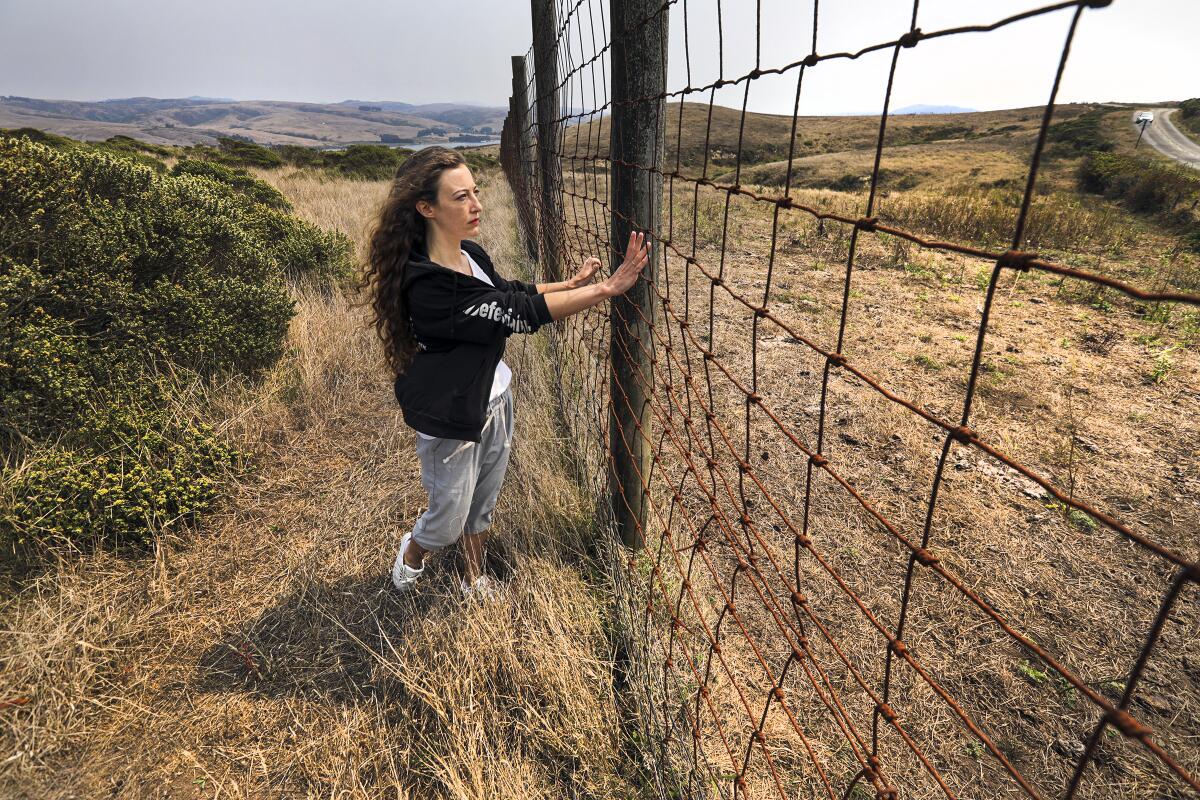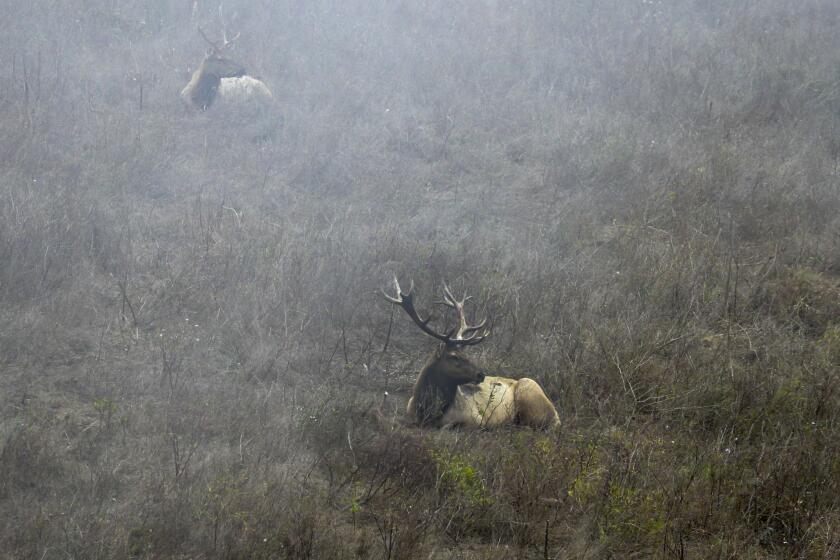Scores of tule elk died at Point Reyes seashore in 2020. Are their days numbered?

- Share via
Tule elk are treasured creatures in California, and for years, animal rights groups have butted heads with the Point Reyes National Seashore over its practice of keeping elk fenced away from nearby cattle ranches.
Amid a dry 2020, the groups tried to bring water to the creatures but were rebuffed by the National Park Service. Now the federal agency has released a report indicating that more than one third of the 445 elk fenced in at Tomales Point died this past winter, bringing the population down to 293.
For the record:
3:34 p.m. April 15, 2021An earlier version of this story incorrectly stated when Point Reyes National Seashore was established. It was 1962, not 1972. The story has also been updated to reflect the available historical record on why the parks service erected the fence across Tomales Point.
In response, activists are again demanding the park service remove an 8-foot-high fence that separates the elk from cattle, saying it is cruel and prevents the animals from reaching water outside the 2,600-acre enclosure.
“I don’t know why the park service is so set on privileging private profit over wildlife at this national park,” said Fleur Dawes, communications director for In Defense of Animals, a San Rafael animal activist group. She added these are modern agriculture operations, “Hardly your small, ‘let’s see Betsy getting milked’ kind of family farm.”
Did lack of water access contribute to the elk’s demise? The park service doesn’t think so. A spokeswoman, Melanie Gunn, said field observations and six necropsies show the elk succumbed to malnutrition, not dehydration.
She said the nutritional quality of the elk’s forage is “likely exacerbated by the drought.”
Point Reyes National Seashore was created to be a “wonderful haven where one can rest at peace with the land and sea,” as U.S. Rep. Clement Woodnutt Miller wrote in authorizing legislation for the protected area in 1962.
Is it appropriate to intervene to help wildlife amid a disaster? That question has arisen in fire-scorched Point Reyes.
But over the last year, a wildfire struck the park — which in non-pandemic times is visited annually by roughly 2.5 million tourists — amid a devastating drought, all under the watchful eyes of environmental groups and animal activists.
At the same time, the National Park Service is finalizing a plan for managing a park beloved by residents of the San Francisco Bay Area and beyond.
On April 22, the California Coastal Commission will weigh in on a new draft of the park’s preferred management plan, which could increase the amount of ranch land in the park from 27,000 to 28,100 acres — 2,000 of those acres will be set aside for protection, with the potential for “targeted” grazing, only. It would also reduce the size of one of the elk populations from 139 to 120, through lethal means.
In one park service proposal — not the agency’s preferred option — the Drake’s Beach tule elk population would be entirely exterminated, although the park service “would evaluate options to donate meat.”
The service’s preferred plan would keep the same number of beef cattle in the park, which is about 2,400, and reduce the number of dairy cows from roughly 3,325 to 3,115.
Park service officials say the new plan, if adopted, will enable them to more effectively manage the ranch lands for the benefit of all.
Critics disagree.
“I can’t see how increasing ranches while depriving these elk from water, and shooting others, provides a benefit for the park,” said Dawes, who noted that the majority of public comments received by the Coastal Commission was against expansion of the ranches.
Although the park service contends that lack of water was not a major cause of the elk death’s last year, it declined to provide The Times with necropsy reports it referenced.
Dawes and others say that during this same period, two other populations in the park — the Drake and Limantour herds, which are not enclosed by fences — did not see these same dramatic die-offs. In the case of the Limantour herd, only 11 animals — roughly 5% of the population — died, while in the Drakes Beach herd, the population grew from 138 animals to 139.
“That stretches credulity, I think,” Dawes said. “For them to suggest that this is somehow a natural event? How is that fence natural? And why is it that animals in the free-ranging herds were miraculously spared from this natural event?”
Gunn said the different herds have different habitats and “forage ability” and suggested there was a bigger drop in Tomales Point because the population is bigger.
Similar declines in elk have occurred in the past, including during a drought from 2013 to 2015. At that time, the population decreased from 540 to 283.
Before the Point Reyes National Seashore was officially established in 1962, ranch families privately owned the land. For nearly a decade after Congress authorized the park in the 1960s, the government worked to buy these private parcels with agreements to allow the ranchers to continue operations for decades, sometimes up to 30 years.
Though elk herds had long roamed the area, they were wiped out by hunting and loss of grazing grounds, as herds of cattle took over.

In 1978, state and federal wildlife managers moved some of the last tule elk in California back to the northern tip of the park at Tomales Point in an attempt to save them from extinction. The population grew.
To prevent elk from pushing onto the grazing lands of nearby farms, where appetizing pastures beckoned, the park service the erected the three-mile-long woven-wire fence that now runs across the peninsula.
As last year’s dry months dragged into September, Dawes and others, including Jack Gescheidt — president of the Tree Spirit Project, a Marin County environmental group — organized a nighttime bucket brigade to bring 150 gallons of water to the elk.
At the time, a 3,000-acre fire was burning in the park, the air was choked with smoke, and the cattle stock ponds the elk often drink from were completely dried up.
Upon hearing about the intervention, the park service dumped the water and confiscated the troughs the activists had hauled in. Park service officials said the elk had plenty of water and that the activists’ actions were illegal and potentially harmful.
In December, the elk crusaders tried again. This time, they were caught, and Gescheidt was cited for “creating a hazardous situation” and “disorderly conduct.”
“Hazardous? To whom? The elk? We were giving them water. We were making it less hazardous,” he said.
The wildlife advocates also fear that water quality in the park could worsen if federal officials expand cattle grazing lands. In January, Gescheidt‘s and Fleur’s groups contracted for water tests at Abbotts and Kehoe Lagoons.
The tests revealed that E. coli levels at Abbotts Lagoon were 20 times greater than what’s considered acceptable, and 40 times greater at Kehoe Lagoon. E. coli is associated with fecal contamination — the bacteria is shed from stomach linings when an animal, or person, defecates — and it can cause illness if ingested by humans and pets.
Tests for Enterococcus, another bacteria associated with cattle feces, was found at levels 300 times the maximum safe amount at Kehoe Lagoon and 60 times the safe level at Abbotts Lagoon.
Gunn, the National Parks Service spokeswoman, said the tests were taken right after it rained and therefore not representative of general water quality. She cited a park service report that documented improving water quality at the national seashore between 1999 and 2013.
Times staff writer Anita Chabria contributed to this report.
More to Read
Sign up for Essential California
The most important California stories and recommendations in your inbox every morning.
You may occasionally receive promotional content from the Los Angeles Times.















